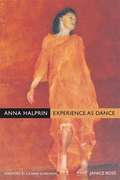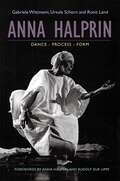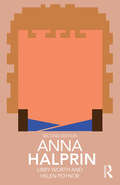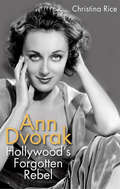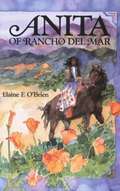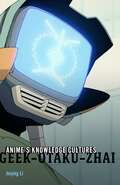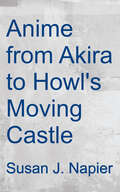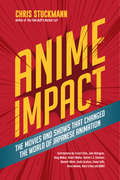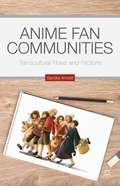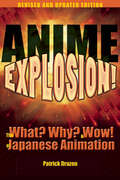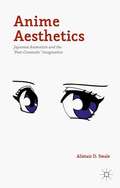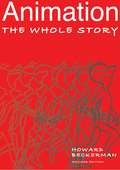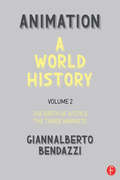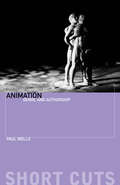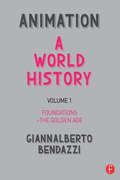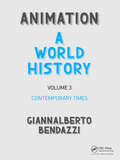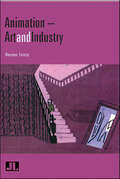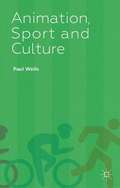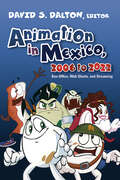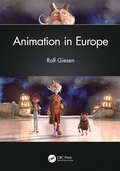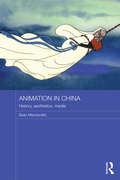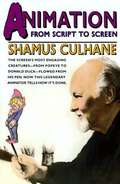- Table View
- List View
Anna Maria's Gift
by Robert Papp Janice ShefelmanReissued with a fresh look and added content, the Stepping Stones History series is kid-friendly and Common Core ready! When Anna Maria's father dies, she moves to an orphanage in Venice. Though she misses her father, she knows he will always be with her, as long as she has his beautiful violin. Luckily, the orphanage is also a renowned music school, with a teacher who is none other than composer Antonio Vivaldi. But when her violin is stolen, Anna Maria must search Venice's bridges, streets, and canals. Will she ever find it--and can she ever be happy in Venice without it? This lyrical historical-fiction story captures Venice, the joy of music, and how kindness can make a scary new place feel like home. History Stepping Stones now feature updated content that emphasizes Common Core and today's renewed interest in nonfiction. Perfect for home, school, and library bookshelves!
Anna Halprin: Experience as Dance
by Janice RossThis first comprehensive biography examines Halprin's fascinating life in the context of American culture--in particular popular culture and the West Coast as a center of artistic experimentation from the Beats through the Hippies.
Anna Halprin: Dance - Process - Form
by Anna Halprin Gabriele Wittmann Ronit Land Ursula Schorn Rudolf Zur LippeAnna Halprin is a world-famous theatre artist and early pioneer in the expressive arts healing movement. This book explores her personal growth as a dancer and choreographer and the development of her therapeutic and pedagogical approach. The authors, who each trained with Halprin, introduce her creative work and the 'Life/Art Process®' she developed, an approach that takes life experiences as a source for artistic expression. They also examine the wider impact of Halprin's work on the fields of art, education, therapy and political action and discuss how she crossed the conventionally defined boundaries between them. Exploring Halprin's belief that dance can be a powerful force for transformation, healing, education, and making our lives whole, this book is a tribute to an exceptional body of artistic and therapeutic work and will be of interest to expressive arts therapists, dance movement psychotherapists, dancers, performance and community artists, and anyone with an interest in contemporary dance.
Anna Halprin (Routledge Performance Practitioners)
by Libby Worth Helen PoynorAnna Halprin traces the life's work of this radical dance-maker, documenting her early career as a modern dancer in the 1940s through to the development of her groundbreaking approach to dance as an accessible and life-enhancing art form. Now revised and reissued, this book: sketches the evolution of the San Francisco Dancers' Workshop, exploring Halprin's connections with the avant-garde theatre, music, visual art and architecture of the 1950s and 60s offers a detailed analysis of Halprin’s work from this period provides an important historical guide to a time when dance was first explored beyond the confines of the theatre and considered as a healing art for individuals and communities. As a first step towards critical understanding, and an initial exploration before going on to further, primary research, Routledge Performance Practitioners offer unbeatable value for today’s student.
Ann Dvorak: Hollywood's Forgotten Rebel (Screen Classics)
by Christina RiceThe forgotten screen legend who made Hollywood history by challenging the all-powerful studio system is revealed in this first full-length biography.Seemingly destined for A-list fame, Ann Dvorak was touted as &“Hollywood&’s New Cinderella&” after film mogul Howard Hughes cast her in the 1932 gangster film Scarface. But Dvorak&’s journey to superstardom was derailed when she walked out on her contractual obligations to Warner Bros. for an extended honeymoon. Ann Dvorak: Hollywood&’s Forgotten Rebel explores the life and career of one of the first individuals who dared to challenge the studio system.Dvorak reached her pinnacle during the early 1930s, when the film industry was relatively uncensored and free to produce movies with more daring storylines. She played several female leads in films including The Strange Love of Molly Louvain, Three on a Match, and Heat Lightning, but after her walk-out, Warner Bros retaliated by casting her in less significant roles.Following the casting conflicts and illness, Dvorak filed a lawsuit against the Warner Bros. studio, setting a precedent for other stars who eventually followed suit. In this insightful memoir, Christina Rice explores the spirited rebellion of a talented actress whose promising career fell victim to the studio empire.
Anita of Rancho Del Mar
by Elaine F. O'BrienDepicts life on a Spanish land-grant ranch in California in the 1830s through the adventures of young Anita and the Lorenzana family.
Anime's Knowledge Cultures: Geek, Otaku, Zhai
by Jinying LiUnlocking the technosocial implications of global geek cultures Why has anime, a &“low-tech&” medium from last century, suddenly become the cultural &“new cool&” in the information age? Through the lens of anime and its transnational fandom, Jinying Li explores the meanings and logics of &“geekdom&” as one of the most significant sociocultural groups of our time. In Anime&’s Knowledge Cultures, Li shifts the center of global geography in knowledge culture from the computer boys in Silicon Valley to the anime fandom in East Asia. Drawing from film studies, animation studies, media theories, fan studies, and area studies, she provides broad cultural and theoretical explanations of anime&’s appeal to a new body of tech-savvy knowledge workers and consumers commonly known as geeks, otaku, or zhai. Examining the forms, techniques, and aesthetics of anime, as well as the organization, practices, and sensibilities of its fandom, Anime&’s Knowledge Cultures is at once a theorization of anime as a media environment as well as a historical and cultural study of transnational geekdom as a knowledge culture. Li analyzes anime culture beyond the national and subcultural frameworks of Japan or Japanese otaku, instead theorizing anime&’s transnational, transmedial network as the epitome of the postindustrial knowledge culture of global geekdom. By interrogating the connection between the anime boom and global geekdom, Li reshapes how we understand the meanings and significance of anime culture in relation to changing social and technological environments.
Anime's Identity: Performativity and Form beyond Japan
by Stevie SuanA formal approach to anime rethinks globalization and transnationality under neoliberalism Anime has become synonymous with Japanese culture, but its global reach raises a perplexing question—what happens when anime is produced outside of Japan? Who actually makes anime, and how can this help us rethink notions of cultural production? In Anime&’s Identity, Stevie Suan examines how anime&’s recognizable media-form—no matter where it is produced—reflects the problematics of globalization. The result is an incisive look at not only anime but also the tensions of transnationality.Far from valorizing the individualistic &“originality&” so often touted in national creative industries, anime reveals an alternate type of creativity based in repetition and variation. In exploring this alternative creativity and its accompanying aesthetics, Suan examines anime from fresh angles, including considerations of how anime operates like a brand of media, the intricacies of anime production occurring across national borders, inquiries into the selfhood involved in anime&’s character acting, and analyses of various anime works that present differing modes of transnationality. Anime&’s Identity deftly merges theories from media studies and performance studies, introducing innovative formal concepts that connect anime to questions of dislocation on a global scale, creating a transformative new lens for analyzing popular media.
Anime from Akira to Howl's Moving Castle: Experiencing Contemporary Japanese Animation
by Susan J. NapierJapanese animation is more popular than ever following the 2002 Academy Award given to Hayao Miyazaki's Spirited Away. It confirmed that anime is more than just children's cartoons, often portraying important social and cultural themes. With new chapters on Spirited Away and other recent releases, including Howl's Moving Castle-- which broke records in Japan--this edition will be the authoritative source on anime for an exploding market of viewers who want to know more.
Anime Impact: The Movies and Shows that Changed the World of Japanese Animation
by Chris StuckmannAn exploration of anime’s masterpieces and game-changers from the 1960s to the present—with contributions from writers, artists, superfans and more.Anime—or Japanese animation—has been popular in Japan since Astro Boy appeared in 1963. Subsequent titles like Speed Racer and Kimba the White Lion helped spread the fandom across the country. In America, a dedicated underground fandom grew through the 80s and 90s, with breakthrough titles like Katsuhiro Otomo’s Akira making their way into the mainstream.Anime Impact explores the iconic anime movies and shows that left a mark on popular culture around the world. Film critic and longtime fan Chris Stuckmann takes readers behind the scenes of legendary titles as well as hidden gems rarely seen outside Japan. Plus anime creators, critics and enthusiasts—including Ready Player One author Ernest Cline, manga artist Mark Crilley, and YouTube star Tristan “Arkada” Gallant—share their stories, insights and insider perspectives.
Anime Fan Communities
by Sandra AnnettHow have animation fans in Japan, South Korea, the United States, and Canada formed communities and dealt with conflicts across cultural and geographic distance? This book traces animation fandom from its roots in early cinema audiences, through mid-century children's cartoon fan clubs, to today's digitally-networked transcultural fan cultures.
Anime Explosion!
by Patrick DrazenAn updated look at Japanese animation, and the manga that inspired them. New chapters on "Fullmetal Alchemist," manga/anime by CLAMP, and Satoshi Kon. It brings fans up to date on Studio Ghibli movies after the Academy Award-winning "Spirited Away," new titles like "Negima" and "Ouran High School Host Club," and breakthrough same-sex stories "Gravitation" and "Mother Mary is Watching."
Anime Classics Zettai!
by Brian Camp Julie DavisFrom Stone Bridge Press, award-winning publishers of The Anime Encyclopedia, Hayao Miyazaki, and The Astro Boy Essays, comes a must-have guide to 100 essential Japanese animation films, TV series, and made-for-video series, from 1950s classics to the latest Cartoon Network hits.Looking for something specific? Eight unique icons make reviews easy to browse. From Akira to Naruto, Pokemon to Sailor Moon, here are summaries, style notes, rare facts, viewer-discretion guides, and critical comments on films that fans absolutely-zettai!-must see. Note: due to rights restrictions the ebook edition does not include images that are in the print edition.Julie Davis is the former editor-in-chief of Animerica: Anime & Manga Monthly. A writer and editor in San Francisco, Davis has translated manga for Viz (now Viz Media) and has contributed to Otaku USA and Manga: The Complete Guide.Brian Camp, program manager at CUNY-TV in New York, was a regular contributor to Animerica: Anime & Manga Monthly, and has taught a course on anime at New York's School of Visual Arts. Camp has also contributed to Animation World, Film Library Quarterly, the Motion Picture Guide, and the New York Daily News.
Anime Aesthetics: Japanese Animation And The 'post-cinematic' Imagination (New Security Challenges)
by Alistair D. SwaleJapanese animation has been given fulsome academic commentary in recent years. However, there is arguably a need for a more philosophically consistent and theoretically integrated engagement. While this book covers the key thinkers of contemporary aesthetic theory, it aims to reground reflection on anime within the aesthetics of R.G. Collingwood.
Animation: The Whole Story
by Howard BeckermanProfessional animator Howard Beckerman has drawn them all: Popeye, Heckle & Jeckle, even Mickey Mouse. In Animation, he offers a road map to the complex art of making an animated feature. Vivid sketches, screen shots, and step-by-step illustrations show how to make a drawing come to life, create storyboards, use form and color, develop a soundtrack, edit, and more. This new edition is also thoroughly updated to reflect the latest trends surrounding digital technology. Animation provides artists and aspiring filmmakers with everything they need to carve their niche in today's quickly evolving animation industry.
Animation: The Birth of a Style - The Three Markets
by Giannalberto BendazziA continuation of 1994's groundbreaking Cartoons, Giannalberto Bendazzi's Animation: A World History is the largest, deepest, most comprehensive text of its kind, based on the idea that animation is an art form that deserves its own place in scholarship. Bendazzi delves beyond just Disney, offering readers glimpses into the animation of Russia, Africa, Latin America, and other often-neglected areas and introducing over fifty previously undiscovered artists. Full of first-hand, never before investigated, and elsewhere unavailable information, Animation: A World History encompasses the history of animation production on every continent over the span of three centuries. Volume II delves into the decades following the Golden Age, an uncertain time when television series were overshadowing feature films, art was heavily influenced by the Cold War, and new technologies began to emerge that threatened the traditional methods of animation. Take part in the turmoil of the 1950s through 90s as American animation began to lose its momentum and the advent of television created a global interest in the art form. With a wealth of new research, hundreds of photographs and film stills, and an easy-to-navigate organization, this book is essential reading for all serious students of animation history.
Animation: Genre and Authorship (Short Cuts)
by Paul WellsAnimation: Genre and Authorship explores the distinctive language of animation, its production processes, and the particular questions about who makes it, under what conditions, and with what purpose. In this first study to look specifically at the ways in which animation displays unique models of ‘auteurism’ and how it revises generic categories, Paul Wells challenges the prominence of live-action moviemaking as the first form of contemporary cinema and visual culture. The book also includes interviews with Ray Harryhausen and Caroline Leaf, and a full timeline of the history of animation.
Animation: Foundations - The Golden Age
by Giannalberto BendazziA continuation of 1994's groundbreaking Cartoons, Giannalberto Bendazzi's Animation: A World History is the largest, deepest, most comprehensive text of its kind, based on the idea that animation is an art form that deserves its own place in scholarship. Bendazzi delves beyond just Disney, offering readers glimpses into the animation of Russia, Africa, Latin America, and other often-neglected areas and introducing over fifty previously undiscovered artists. Full of first-hand, never before investigated, and elsewhere unavailable information, Animation: A World History encompasses the history of animation production on every continent over the span of three centuries. Volume I traces the roots and predecessors of modern animation, the history behind Émile Cohl's Fantasmagorie, and twenty years of silent animated films. Encompassing the formative years of the art form through its Golden Age, this book accounts for animation history through 1950 and covers everything from well-known classics like Steamboat Willie to animation in Egypt and Nazi Germany. With a wealth of new research, hundreds of photographs and film stills, and an easy-to-navigate organization, this book is essential reading for all serious students of animation history.
Animation: Contemporary Times
by Giannalberto BendazziA continuation of 1994's groundbreaking Cartoons, Giannalberto Bendazzi's Animation: A World History is the largest, deepest, most comprehensive text of its kind, based on the idea that animation is an art form that deserves its own place in scholarship. Bendazzi delves beyond just Disney, offering readers glimpses into the animation of Russia, Africa, Latin America, and other often-neglected areas and introducing over fifty previously undiscovered artists. Full of first-hand, never before investigated, and elsewhere unavailable information, Animation: A World History encompasses the history of animation production on every continent over the span of three centuries. Volume III catches you up to speed on the state of animation from 1991 to present. Although characterized by such trends as economic globalization, the expansion of television series, emerging markets in countries like China and India, and the consolidation of elitist auteur animation, the story of contemporary animation is still open to interpretation. With an abundance of first-hand research and topics ranging from Nickelodeon and Pixar to modern Estonian animation, this book is the most complete record of modern animation on the market and is essential reading for all serious students of animation history.
Animation: Art and Industry
by Maureen FurnissAnimation—Art and Industry is an introductory reader covering a broad range of animation studies topics, focusing on both American and international contexts. It provides information about key individuals in the fields of both independent and experimental animation, and introduces a variety of topics relevant to the critical study of media—censorship, representations of gender and race, and the relationship between popular culture and fine art. Essays span the silent era to the present, include new media such as web animation and gaming, and address animation made using a variety of techniques.
Animation, Sport and Culture
by Paul WellsAnimation, Sport and Culture is a wide-ranging study of both sport and animated films. From Goofy to Goalkeepers, Wallace and Gromit to Tiger Woods, Mickey Mouse to Messi, and Nike to Nationhood, this Olympic-sized analysis looks at the history, politics, aesthetics and technologies of sport and animation from around the globe.
Animation in Mexico, 2006 to 2022: Box Office, Web Shorts, and Streaming (SUNY series in Latin American Cinema)
by David S. DaltonExamines contemporary animation in Mexico—one of the most commercially successful and most understudied genres of the national cinema.Answering a call to view Mexican film through the lens of commercial cinema, Animation in Mexico, 2006 to 2022 is the first book-length study of the country's animated cinema in the twenty-first century. As such, the volume sheds light on one of the country's most strategically important and lucrative genres, subjecting it to sustained intellectual analysis for the first time. Building on earlier film history, David S. Dalton identifies two major periods, during which the focus shifted from success at the national box office to internationalization and streaming. In eight original essays, contributors use an array of theoretical and disciplinary approaches to interrogate how this popular genre interfaces with Mexican politics and society more broadly, from Huevocartoon to Coco and beyond. The book will appeal to students, scholars, and fans of Mexican film by situating animation within broader currents in the field and the industry.
Animation in Europe
by Rolf GiesenThere is a lot one could say about animation in Europe, but above all, there is no consistent European animation. It is as disparate as the various countries involved. Audiences will certainly recognize American or Japanese animation, but in Europe, it can range from Czech, Polish, and Hungarian to Greek, Italian, Spanish, Portuguese, French, and British. Animation in Europe provides a comprehensive review of the history and current situation of animation in over 20 European countries. It features numerous interviews with artists and producers, including rare documents and firsthand accounts that illustrate the rich history of animation in Europe. Additional features include • An extensive chronology with key events in European animation • A Who’s Who of producers, directors, writers, and animators working in Europe • An examination of the origin of European animation and its influence Animation in Europe is the first book devoted entirely to this topic and, therefore, will be of value for animation buffs as well as practitioners and researchers.
Animation in China: History, Aesthetics, Media (Routledge Contemporary China Series)
by Sean MacdonaldBy the turn of the 21st century, animation production has grown to thousands of hours a year in the People’s Republic of China (PRC). Despite this, and unlike American blockbuster productions and the diverse genres of Japanese anime, much animation from the PRC remains relatively unknown. This book is an historical and theoretical study of animation in the PRC. Although the Wan Brothers produced the first feature length animated film in 1941, the industry as we know it today truly began in the 1950s at the Shanghai Animation Film Studio (SAFS), which remained the sole animation studio until the 1980s. Considering animation in China as a convergence of the institutions of education, fine arts, literature, popular culture, and film, the book takes comparative approaches that link SAFS animation to contemporary cultural production including American and Japanese animation, Pop Art, and mass media theory. Through readings of classic films such as Princess Iron Fan, Uproar in Heaven, Princess Peacock, and Nezha Conquers the Dragon King, this study represents a revisionist history of animation in the PRC as a form of "postmodernism with Chinese characteristics." As a theoretical exploration of animation in the People’s Republic of China, this book will appeal greatly to students and scholars of animation, film studies, Chinese studies, cultural studies, political and cultural theory.
Animation from Script to Screen
by Shamus CulhaneShamus Culhane, the animator who made the dwarfs in Snow White, achieves something few are able to: He makes it possible to learn a concrete skill from a book. Covering every aspect of film animation, from basic mechanics to giving creativity full play, and including writing, recording, acting, dialogue-even how to mange an animation studio of one's own, Culhane fulfills the promise of his title-"from script to screen."

